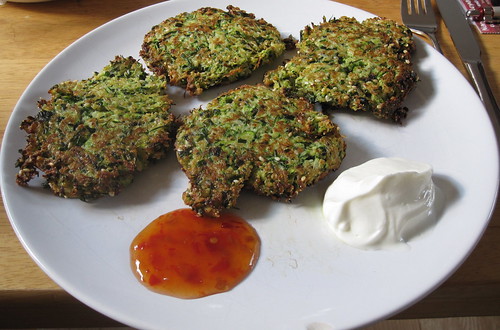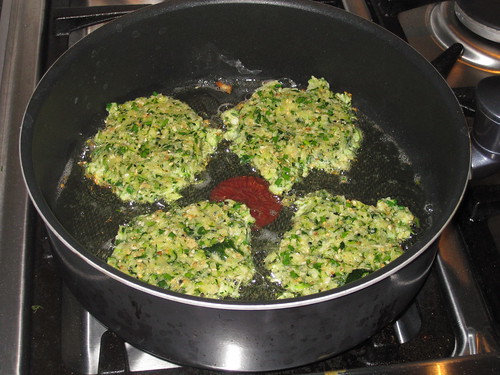We've finished our massive bread surplus and today I'll bake bread. Still there's way too much of my sourdough starter Monty for comfort, so I also decided to try and make cinnamon buns. I'm writing this entry as I make the buns, but will do an ingredients and method list at the bottom.
I prepared by reading through the great posts about
Baker's Percentage from
Susan at Wildyeastblog. Then I converted my
existing recipe according to the instructions, but since my original measurements are by volume, I wasn't at all sure where I'd end up with. I did find a sort of
volume to weight conversion web site.
I made up a table of how much of each ingredient I should use given that I'm using starter instead of yeast. But to be on the safe side, I also measured things up by weight "in reality" after I fed Monty. Poor Monty, he was very hungry, he had about half a cm layer of hooch on the surface. I removed that.
So I fed him 250 g water and 250 g strong white flour and had to split him up into two jars.
Next I weighed up the 1 litre of flour, that was spot on 700 g. I'd decided to use 300 g of starter, which according to the Baker's Percentage calculations would equate to 150 g flour + 150 g water.
Thus, 700 g (the total amount of flour give or take) - 150 g (contributed by Monty) = 550 g (what I'll need to add to make my dough). It was well sticky, so I added another 50 g of flour.
Liquids now. The recipe says 0.5 litre milk. That's about 500 g, but Monty contributes 150 g of that, so I'll only need 350 g.
At this point I took out the butter from the fridge and measured up two pieces of 100 g each. One for the dough, one for the filling. My kitchen is extremely hot these days and this didn't take long, so I prepared the filling: 140 g granulated sugar and 18 g ground cinnamon mixed in with the 100 g soft butter.
Then decided to add some experimentation. A yeast dough needs to develop gluten and fat tends to prevent that. The recipe says to melt the butter and mix into the dough with the milk at the start. This would imply that the dough will need to be worked for longer in order to develop the gluten. So I decided to keep the butter solid and knead it in after gluten has been developed, pretty much like in
Brioche. I also had some ground almonds that I wanted to use up, so decided to include them in the filling.
And I remembered to prepare my egg wash early - one egg whisked together with a pinch of salt and set aside. This makes the egg runnier and more bright yellow, on the verge of orange.
Although my starter seemed very vigorous today - doubled in size in just under 3 h, I still needed to let the dough rise for a bit longer than the 40 minutes I've stated in the original recipe. The dough was still very soft and a bit on the sticky side. It weighed in at 1472 g, so I divided it in two, sprinkled a bit of flour on the work surface and the rolling pin and rolled out the dough. I managed to roll it quite thin and struggled to cover all of it with the filling. Then had a terrible time rolling it up, it was well stuck to the surface and I had to carefully scrape it off and roll it up. I ended up with something that looked like a rugged long slug, but I cut it up and placed in the paper cups and pressed down a bit and it took on the expected shape. This time I ended up with 34 buns.
The proofing was just over an hour, again, they swelled up a bit, but perhaps not as much as they might have with yeast. Maybe I should have done two batches simultaneously for comparison.
My oven was playing up again and instead of the 8 - 12 minutes, I ended up baking for quite a lot longer. Bah!
But the result was very good, possibly I need to increase the amount of sugar both in the dough and in the filling, they could be a bit sweeter. And I think I keep saying that every time I make (regular) cinnamon buns and keep forgetting. The ground almonds addition was a good one, though Lundulph said he didn't notice it.
Ingredients1 egg
pinch of salt
100 g soft unsalted butter
18 g ground cinnamon
150 g granulated sugar
50 g ground almonds (optional)
300 g white sourdough starter at 100% hydration
600 g strong white flour
350 g milk (at room temperature)
150 g caster sugar
2 tbsp cardamom
100 g soft unsalted butter
Method- Whisk the egg lightly with the salt and set aside until needed.
- Bring both amounts of butter up to room temperature, then mix one of them with granulated sugar and cinnamon and set aside until needed.
- Assuming the starter has been fed and is ready to use, mix it with the flour, milk, caster sugar and cardamom and work until full gluten development.
- Add the soft butter and work in well, then set the dough aside to rise until double in size.
- Divide the dough into two equal parts, dust the work surface with flour and roll out one part at a time to a rectangular shape and thickness of 5 mm.
- Spread half of the cinnamon filling evenly over the rolled out piece, all the way to the edges.
- Optionally sprinkle ground almonds over the filling, then roll up along the longer side of the rectangle.
- Cut the roll into pieces of 2 - 3 cm width and place in paper cups or on a baking tray lined with greaseproof paper.
- Let proof for about an hour until the buns have doubled in size. In the mean time pre-heat the oven to 200 degrees C.
- Bake until golden brown, then let cool on a wire rack.
In the listing above, I've adjusted the sugar, hopefully I'll get it right next time.



